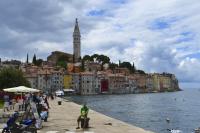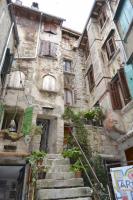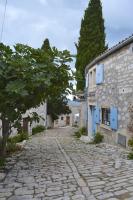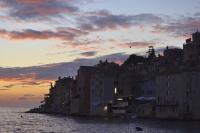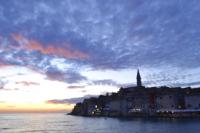ROVINJ JULY 2012
For me, the world is only as big as what’s between my ears. In other words, I only know what I see and read. So what I got from the sleepy seaside town on the Croatian Istrian Peninsula called Rovinj (pronounced Roh-VEEN) was - and not to undersell it - it is as it always was.
Extending out into the Adriatic like a red-tiled thumb, Rovinj and its old town sits on a rock at the most northwesterly corner of Croatia’s sickle-shaped map, tempting camera lenses and romancing couples to sigh and breathe deep. But even with its postcard quality, Rovinj still likes fishing boats more than yachts, apartments more than hotels and hard work more than of “me first” kinds of leisure. Its community is very present and purely salt-of-the-earth.
Still Rovinj seems tailor-made for those more suited to tourist hotspots like Venice and Dubrovnik, and the stalls selling fridge magnets and beach towels would lead you to believe it, but as if to directly contradict that perception, my new wife and I dined on perfect sea-fresh fish, delicious beef dishes prepared with the utmost care and chatted with locals who were totally unconcerned about any “tourist reputation”. People seem to have sidestepped those concerns by being pure and true to their city’s deep roots.
Don’t get me wrong, Rovinj is popular with visitors, and its name can be found in more and more guidebooks as the months go by, but the odd lack of tourist buses waiting in the wings will tell you otherwise. Either way, there’s plenty to do (mountain biking, beach comas, rock climbing, boat excursions, dreaming wistfully about your potential Adriatic heritage) and you will feel like it was heaven-sent just for you.
The town itself was an island until 1763 when some industrious souls decided to link it with the mainland. But it actually dates back to the 3rd century when Illyrian tribes settled here, later taking on the flourishes of Venice when it became part of its Republic in 1283. But its history and age are a mere grace note to the hours you spend there. More importantly it’s the atmosphere that fills your lungs. A stroll through the old town’s steep streets, peeking into artist’s studios along the corridors, browsing the little outdoor market - picking up a bottle of grappa or a bag of walnuts or pears will make a local’s morning - it all seems so utterly charming and safe you don’t know whether to sing or lay down and die. Perhaps the photos you take will convey a town with the sensibility to put its most historical boat, the tiny Batana boat, on wheels next to the main square as an effort not in kitsch but in honesty, and as real as it gets.
Up on the hill St. Euphemia Church is the town’s cake topper. The weathervane at its pinnacle orchestrates the storm clouds like a conductor, telling them just when to launch into their springtime symphony of thunder and rain. You can climb the wooden staircase inside, popping out onto the observation deck wondering how the thing remains standing after all these years. There’s a staircase to the bells, but please try to obey the sign, “Do not ring the bells”.
